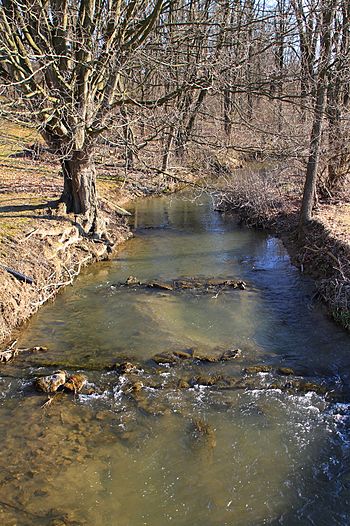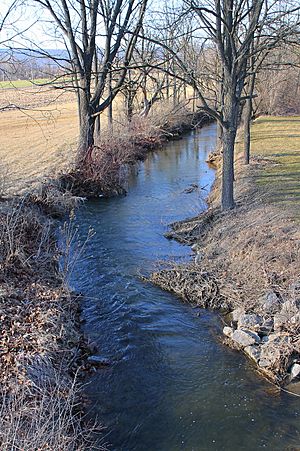Beaver Run (Buffalo Creek tributary) facts for kids
Quick facts for kids Beaver Run |
|
|---|---|

Beaver Run looking upstream from Pennsylvania Route 192
|
|
| Physical characteristics | |
| Main source | near the intersection of Pheasant Ridge Road and Dreisbach Church Road in Buffalo Township, Union County, Pennsylvania between 540 and 560 feet (160 and 170 m) |
| River mouth | Buffalo Creek in Buffalo Township, Union County, Pennsylvania 492 ft (150 m) 40°57′59″N 76°59′05″W / 40.96631°N 76.98484°W |
| Length | 3.7 mi (6.0 km) |
| Basin features | |
| Progression | Buffalo Creek → West Branch Susquehanna River → Susquehanna River → Chesapeake Bay |
| Basin size | 4.78 sq mi (12.4 km2) |
Beaver Run is a small stream, also called a tributary, located in Union County, Pennsylvania. It flows into a larger stream called Buffalo Creek. The stream is about 3.7 miles (6 kilometers) long. It flows mostly through Buffalo Township.
The area of land that drains into Beaver Run, called its watershed, is about 4.78 square miles (12.4 square kilometers). The stream was named before 1769 because of a large beaver dam that used to be near where it joins Buffalo Creek.
Beaver Run is considered an "impaired" stream. This means its water quality isn't as good as it should be. The main problem is siltation, which is when too much dirt and mud washes into the water. This often comes from agricultural activities in the area. Most of the land around Beaver Run is used for farming.
Even with these challenges, Beaver Run is important for fish. It's known as a coldwater fishery, meaning it's cool enough for certain fish. It's also a migratory fishery, which means fish travel through it.
Contents
Where Does Beaver Run Flow?
Beaver Run starts in Buffalo Township, near where Pheasant Ridge Road and Dreisbach Church Road meet. It flows north for a bit, then turns west. It then enters a small town called Vicksburg.
In Vicksburg, the stream crosses Pennsylvania Route 45. After leaving Vicksburg, it turns north again. It flows through a shallow valley for over a mile. Finally, it crosses Pennsylvania Route 192 and joins Buffalo Creek. Beaver Run meets Buffalo Creek about 8.6 miles (13.8 kilometers) before Buffalo Creek reaches its own end.
Other Streams Joining Beaver Run
Beaver Run doesn't have any named streams flowing into it. However, it does have several smaller, unnamed streams that join it. These smaller streams also have water quality problems. They are affected by siltation, just like Beaver Run, mostly due to farming.
Water Quality of Beaver Run
Beaver Run has some water quality issues. The Pennsylvania Department of Environmental Protection officially listed it as an impaired stream in 2008. This means about 7.8 miles (12.6 kilometers) of Beaver Run and its smaller streams are not as healthy as they should be.
The main problem is too much silt, which is fine dirt and mud. This silt comes from farming activities in the area. Even though it's impaired, Beaver Run doesn't add a lot of pollution to Buffalo Creek. This is because it's a relatively small stream.
Pollution in the Water
Beaver Run has high levels of certain pollutants. These include:
- Sediment: This is the dirt and mud that washes into the stream. In 2000, there was a lot of sediment, mostly from row crops (like corn or soybeans) and erosion from the stream banks.
- Nitrogen: This is a nutrient that can cause problems in water if there's too much of it. High levels of nitrogen in Beaver Run mainly come from groundwater and farm fields.
- Phosphorus: This is another nutrient. High levels of phosphorus in Beaver Run mostly come from row crops.
Scientists believe that with efforts to improve the land, the amounts of sediment, nitrogen, and phosphorus in Beaver Run could be greatly reduced in the future.
Land and Environment Around Beaver Run
The land around Beaver Run is part of the Appalachian Mountains. The stream's starting point is higher up, between 540 and 560 feet (165 and 171 meters) above sea level. Where it joins Buffalo Creek, the elevation is about 492 feet (150 meters).
The ground around Beaver Run is made up of two main types of rock formations. Each type covers about half of the stream's watershed. The most common type of soil in the area is called Edom-Millheim-Calvin soil.
On average, the area around Beaver Run gets about 44.5 inches (113 centimeters) of rain each year.
Land Use in the Watershed
The watershed of Beaver Run is mostly farmland. About 83 percent of the land is used for agriculture. Only a small part, about 6 percent, is covered by forests. About 7 percent of the land is covered by hard surfaces like roads or buildings.
There are about 7.3 miles (11.7 kilometers) of streams in the Beaver Run watershed. Most of these, about 6.2 miles (10 kilometers), flow through agricultural land.
To help the stream, more trees and plants could be planted along its banks. These plants create a riparian buffer that helps filter out pollution and prevent erosion. Also, more fences could be built along the stream to keep farm animals out of the water.
History of Beaver Run
Beaver Run was officially added to the Geographic Names Information System in 1979. It got its name sometime before 1769. The name comes from a large beaver dam that was once located near where the stream flows into Buffalo Creek.
A bridge was built over Beaver Run in Vicksburg in 1940. This bridge carries Pennsylvania Route 45.
For a while, Beaver Run was not considered impaired. However, in 2006, a local group called the Buffalo Creek Watershed Association asked the Pennsylvania Department of Environmental Protection to re-evaluate the stream. They had found signs that the water quality was worse than thought. Because of this, Beaver Run was officially listed as impaired in 2008.
In a report from 2008, the Beaver Run watershed was ranked as a high priority for restoration efforts. This means people want to work on making the stream healthier.
Animals and Plants in Beaver Run
Beaver Run is important for fish because it's a coldwater fishery and a migratory fishery. This means it's a good place for fish that like cold water and for fish that travel to different places.
However, the stream has a low variety of macroinvertebrates that are sensitive to pollution. Macroinvertebrates are small creatures without backbones, like insects and worms, that live in the water. A low variety of pollution-sensitive ones can be a sign of water quality problems.
The stream also has a high level of pathogens, which are tiny organisms that can cause disease. These pathogens mostly come from urban areas and farm animals.
Images for kids




